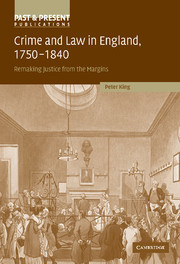Book contents
1 - Shaping and remaking justice from the margins. The courts, the law and patterns of lawbreaking 1750–1840
Published online by Cambridge University Press: 25 July 2009
Summary
The late eighteenth and early nineteenth centuries witnessed many high profile changes in the criminal justice system of England and Wales. The capital code, which had threatened so many property offenders with the long shadow of the gallows, was repealed. Formal, centrally initiated policing and prison reforms increased in importance and moved from an initial reliance on permissive and enabling legislation towards a greater emphasis on compulsion and centrally organised inspection. The causes of these changes, their impact and the degree to which local reforms had already achieved major changes before formal legislation was introduced have all produced extensive debates among historians of crime. However, in the process other important dimensions of criminal justice history were often marginalised in the early stages of the development the field. Four of the most obvious of these – gender, youth, attitudes to non-lethal violence and the criminalisation of customary rights – are focused on here. None of these areas attracted major attention from parliament or from central government for most of the period from 1750 to 1840, yet in each the courts systematically pursued policies which often had a major role in shaping how justice was actually experienced on the ground. By studying the courts' policies in relation to these issues – and in the case of youth and gender by analysing related changes in patterns of formal prosecution – this volume forms part of a broader recent movement among historians which aims to provide a more holistic picture of the ways the criminal justice system was shaped and remade in this period. In the process it highlights both important changes and substantial, yet often neglected, elements of continuity in attitudes to crime, in prosecution patterns and in court policies towards offenders.
- Type
- Chapter
- Information
- Crime and Law in England, 1750–1840Remaking Justice from the Margins, pp. 1 - 70Publisher: Cambridge University PressPrint publication year: 2006



